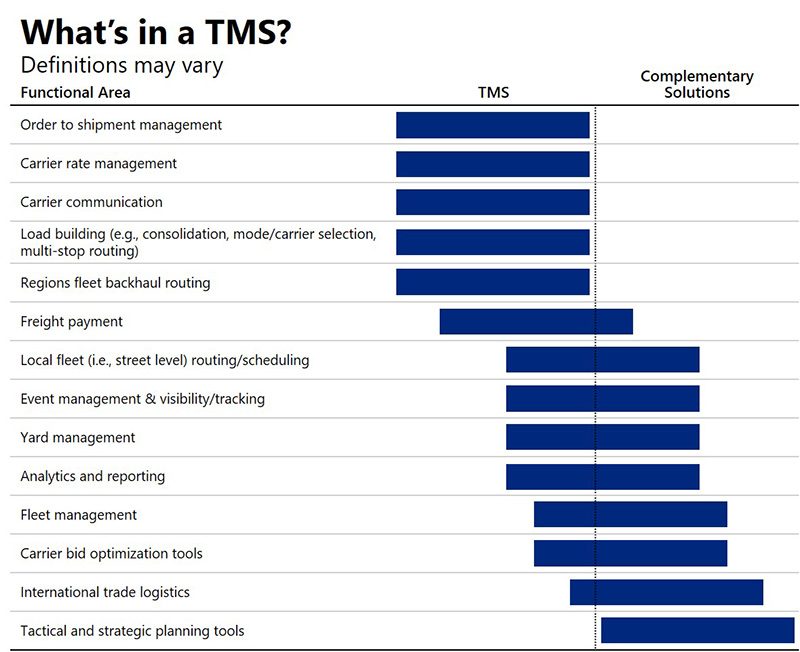Transportation is transportation. Not much change there except for the talk about autonomous trucks, right? Well, not exactly. Especially if you're taking a look at the NextGen evolution of transportation management systems (TMS).
The software doesn't manage the warehouse, pick orders or do tactical or strategic planning in the supply chain today.
However, TMS does manage the transportation of goods, including shipment and rate management functions as well as load building and back hauling not to mention carrier communication.
All important functions, but limited in scope for sure. At least, that's the way TMS has been.
Talk to some experts in the field and it's clear that TMS is on the move to expand its portfolio.
Over at Chainalytics, vice president of the transportation practice, Kevin Zweier, talks about how capabilities of TMS are expanding.
He goes so far as to say the expansion of TMS across all modes is the dominant trend in the software today.
This chart from Chainalytics shows five key functions core to the software today.

The other nine functions in the chart are accomplished by an integration of TMS and complementary software solutions. Now don't look for TMS to run the warehouse or picking. But do look for it to be actively involved in the tactical and strategic planning tools going forward. And the expansion of its capabilities is not going to stop there.
The perfect example of those planning tools is the development of carrier capacity management, explains Geoffrey Milsom, senior director of enVista's transportation consulting practice. Being effective here requires both strategic and tactical sourcing to facilitate carrier capacity at a reasonable price.
Milsom says the objective is not just better utilization of equipment but of drivers down to the specific day or days of use. Not to mention delivering a better shipper experience when shipments and deliveries occur on schedule.
Making that happen going forward requires TMS to team up with several NextGen technologies, says Chris Cunnane, senior analyst at ARC Advisory Group.
“There are NextGen TMS solutions out there that are or will be using machine learning (artificial intelligence or AI), advanced analytics and Internet of Things (IoT) to drive efficiencies for shippers and carriers alike,” he says. Part of TMS' expansion into the planning process is last-mile routing. “Machine learning and AI will be very important here,” says Cunnane.
“The time a job takes to complete is dependent not just on the miles that need to be driven, but on the congestion, the product being delivered, the type of delivery destination and value-added services,” he adds. “Machine learning can be used to ‘learn' these constraints rather than having to do time studies and hard code these constraints into the solution.”
There are other NextGen technologies likely to team up with TMS, says Milsom. One is blockchain. But he expects that to be a longer process than autonomous trucking. He expects long-haul, over-the-road and irregular route trucking to all benefit greatly from autonomous trucking managed by expanded TMS capabilities.
A key player in the development of TMS' expanding capabilities is the Cloud. In the accompanying NextGen: The Interview, Zweier says that “Cloud is a now thing not a future thing. All TMS will eventually be in the Cloud. Cloud improves usability of the software as well as the user experience.”
Cloud also makes it possible to integrate TMS, not just with complementary software solutions but with NextGen technologies from AI to IoT. The outcome, says Cunnane, is “smarter systems, improved visibility, an increased use of sensors for real-time asset tracking, temperature controls and other metrics.”
Visibility is increasingly becoming a big deal with TMS. According to Milsom, 50 to 60% of shippers and 3PLs use TMS today. But less than 10% of those TMS users have an external or third party visibility software application integrated into their TMS for real-time visibility. However, that breadth of use is rising rapidly thanks to the hard dollar value of visibility solutions, says Milsom.
In fact, hard dollar value has long been a strong suit of TMS. And it's getting better even before the expansion of TMS' capabilities. Cunnane says that a recent ARC survey shows an average 8% freight cost savings with TMS. “That's a two percentage point improvement from the last time ARC surveyed TMS users,” he adds. “As TMS functionality improves, systems become ‘smarter' and e-commerce and omni-channel become more important, TMS will continue to drive efficiencies.”
From all indications, Cunnane has it right when he says, “it is truly a time of innovation in the transportation space.”
Gary Forger is the special projects editor for Supply Chain Management Review. He can be reached at [email protected].
SC
MR


More TMS
- Port of Baltimore May Not Reopen Until Summer
- Cargo Shipping Remains on Hold in Baltimore Following Bridge Collapse
- Baltimore Bridge Collapse Latest Supply Chain Disruption
- How to Create Real Retailer-Brand Loyalty
- A Market-Based Routing Guide Strategy for Truckload Transportation
- 32nd Annual Study of Logistics and Transportation Trends: Navigating a Shallow Pool of Resources
- More TMS
Latest Podcast

 Explore
Explore
Topics
Business Management News
- Technology’s role in mending supply chain fragility after recent disruptions
- Survey reveals strategies for addressing supply chain, logistics labor shortages
- How CPG brands can deliver on supplier diversity promises
- How S&OP provides the answer to in-demand products
- AI, virtual reality is bringing experiential learning into the modern age
- Tips for CIOs to overcome technology talent acquisition troubles
- More Business Management
Latest Business Management Resources

Subscribe

Supply Chain Management Review delivers the best industry content.

Editors’ Picks




